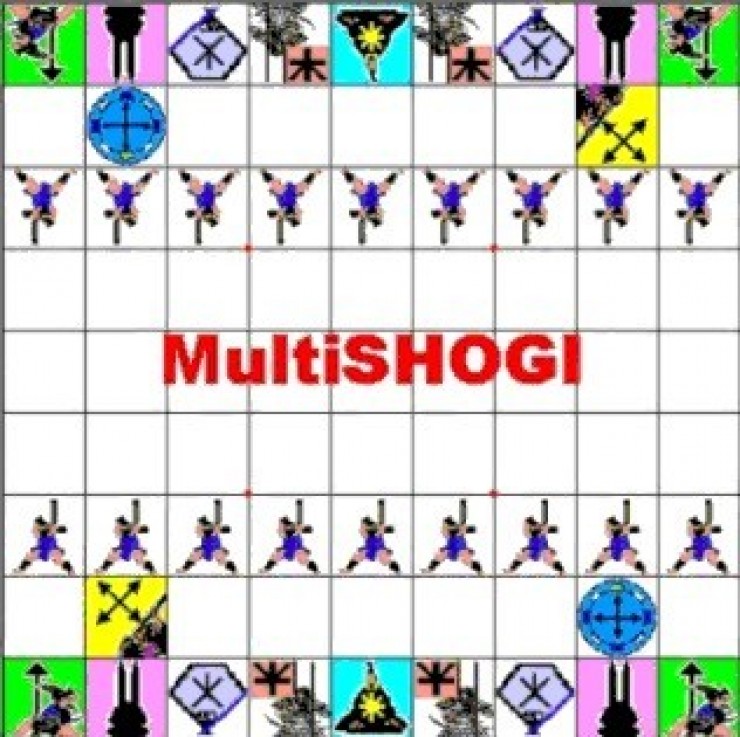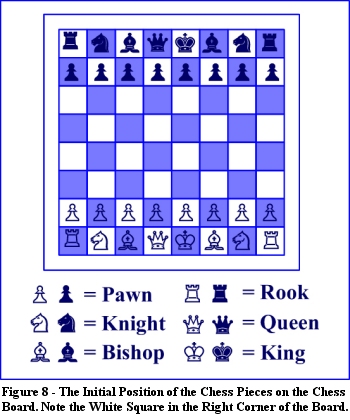

The cannons are placed on the row behind the soldiers, directly in front of the horses (if the horses are put on the file next to the chariots). The chariot is the most powerful piece in the game. The two chariots begin the game in the corners. Additionally, the chariot may move along the diagonal lines inside either palace, but only in a straight line. Like the rook in Western chess, the chariot moves and captures in a straight line either horizontally or vertically. An elephant can be transposed with an adjacent horse in the initial setup.

The janggi elephant can therefore be used more offensively than the xiangqi elephant. Unlike xiangqi, which confines elephants to their own side of the board behind a "river", in janggi there is no river and elephants are not limited to one side of the board. Like the horse, the elephant is blocked from moving by any intervening pieces (the red circles in the diagram). They move one point orthogonally followed by two points diagonally away from their starting point, ending on the opposite corner of a 2×3 rectangle. The elephants or sang 상 ( 象) begin the game to the left and right of the guards. A horse can be transposed with an adjacent elephant in the initial setup. This piece is exactly the same as the horse in xiangqi (i.e. If there is a piece on its first step (the red circles in the diagram), it's restricted to moving in that direction. The horse moves one step orthogonally then one step diagonally outward, with no jumping. They are valuable for protecting the general.Ĭalled the horse or ma 마 ( 馬). The guards are one of the weakest pieces because they may not leave the palace. They move the same as the general, one step per turn along marked lines in the palace. The guards start to the left and right of the general on the first rank. They are often called guards, since they stay close to the general.

council members serving the commander in chief). The pieces are labeled sa 사 ( 士) and are civilian government officials (i.e. If a player has no legal move left, he is just forced to pass and the other player can still continue. Stalemate doesn't result in the end of a game in janggi. The game ends up a draw if both side pass. Unless the general is in check, there is no restriction on when or how many times one can pass during the game. In janggi, a player may pass his turn, which is called "한수쉼 (han-soo-swim)". This rule is different from that of xiangqi where it is illegal for the generals to face. If the generals come to face each other across the board, and the player to move does not move away, this is bikjang-a draw. The general cannot leave the palace under any circumstances. When the general is checkmated the game is lost. There are four diagonal lines in the palace connecting the centre position to the corners. The general may move one step per turn along marked board lines to any of the nine points within the palace. Janggi differs from its Chinese counterpart in that the janggi general starts the game from the central intersection of the palace, rather than from the centre intersection of the back edge. Both kings can also be referred to generally as gung ( 宮, "palace").

In North Korea, the Chu–Han setup is not used the red general there is called jang ( 將, "general") and the blue general is called gwan ( 官, "minister"). They represent the rival states of Han and Chu that fought for power in the post- Qin Dynasty interregnum period in China (see Chu–Han contention). They are labelled with the Chinese character Han 한 (in Chinese pinyin: Hàn 漢) on the red side, and Cho 초 ( Chǔ 楚) on the blue side. The pieces that are equivalent to the kings in Western chess are actually referred to as military generals ( 將軍 janggun) in Korean. The characters on the red pieces are all written in the regular script ( 楷書 Regular script) while the blue/green pieces are all written in the semi-cursive script ( 行書 Running script). The pieces are labelled with hanja ( 漢字 Chinese characters). The palace contains four diagonal lines extending outwards from the centre, forming an "X" shape. Each side has a palace that is 3 lines by 3 lines (9 positions) in the centre of their side of the board against the back edge. The sides are Blue (or sometimes Green), which moves first, versus Red. Janggi pieces are traditionally octagonal in shape, and differ in size according to their rank. The pieces consist of disks marked with identifying characters and are placed on the line intersections (as in xiangqi and Go in China). The board has nearly the same layout as that used in xiangqi, except the janggi board has no "river" in the central row. The board is composed of 90 intersections of 9 vertical files and 10 horizontal rows.


 0 kommentar(er)
0 kommentar(er)
